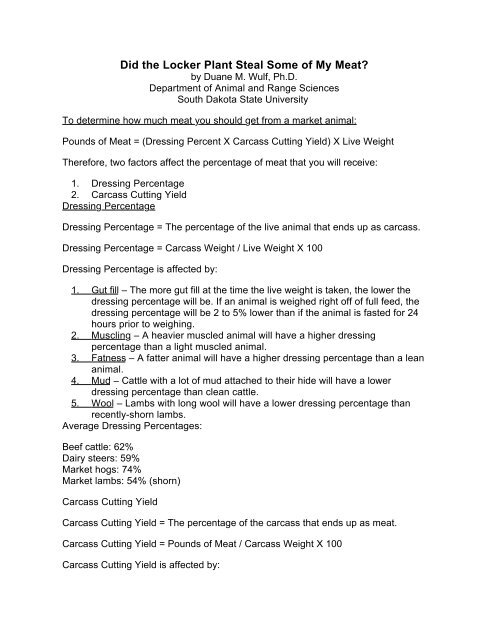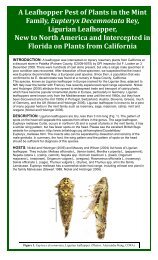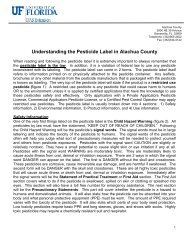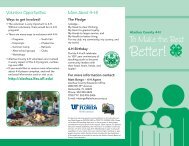Did the Locker Plant Steal Some of My Meat? (PDF)
Did the Locker Plant Steal Some of My Meat? (PDF)
Did the Locker Plant Steal Some of My Meat? (PDF)
Create successful ePaper yourself
Turn your PDF publications into a flip-book with our unique Google optimized e-Paper software.
<strong>Did</strong> <strong>the</strong> <strong>Locker</strong> <strong>Plant</strong> <strong>Steal</strong> <strong>Some</strong> <strong>of</strong> <strong>My</strong> <strong>Meat</strong>?<br />
by Duane M. Wulf, Ph.D.<br />
Department <strong>of</strong> Animal and Range Sciences<br />
South Dakota State University<br />
To determine how much meat you should get from a market animal:<br />
Pounds <strong>of</strong> <strong>Meat</strong> = (Dressing Percent X Carcass Cutting Yield) X Live Weight<br />
Therefore, two factors affect <strong>the</strong> percentage <strong>of</strong> meat that you will receive:<br />
1. Dressing Percentage<br />
2. Carcass Cutting Yield<br />
Dressing Percentage<br />
Dressing Percentage = The percentage <strong>of</strong> <strong>the</strong> live animal that ends up as carcass.<br />
Dressing Percentage = Carcass Weight / Live Weight X 100<br />
Dressing Percentage is affected by:<br />
1. Gut fill – The more gut fill at <strong>the</strong> time <strong>the</strong> live weight is taken, <strong>the</strong> lower <strong>the</strong><br />
dressing percentage will be. If an animal is weighed right <strong>of</strong>f <strong>of</strong> full feed, <strong>the</strong><br />
dressing percentage will be 2 to 5% lower than if <strong>the</strong> animal is fasted for 24<br />
hours prior to weighing.<br />
2. Muscling – A heavier muscled animal will have a higher dressing<br />
percentage than a light muscled animal.<br />
3. Fatness – A fatter animal will have a higher dressing percentage than a lean<br />
animal.<br />
4. Mud – Cattle with a lot <strong>of</strong> mud attached to <strong>the</strong>ir hide will have a lower<br />
dressing percentage than clean cattle.<br />
5. Wool – Lambs with long wool will have a lower dressing percentage than<br />
recently-shorn lambs.<br />
Average Dressing Percentages:<br />
Beef cattle: 62%<br />
Dairy steers: 59%<br />
Market hogs: 74%<br />
Market lambs: 54% (shorn)<br />
Carcass Cutting Yield<br />
Carcass Cutting Yield = The percentage <strong>of</strong> <strong>the</strong> carcass that ends up as meat.<br />
Carcass Cutting Yield = Pounds <strong>of</strong> <strong>Meat</strong> / Carcass Weight X 100<br />
Carcass Cutting Yield is affected by:
1. Fatness – Leaner animals will have higher carcass cutting yields than fatter<br />
animals.<br />
2. Muscling – More muscular animals will have higher carcass cutting yields<br />
than less muscular animals.<br />
3. Bone-in versus Boneless – This will dramatically affect carcass cutting yield.<br />
If more boneless cuts that are made, <strong>the</strong>n <strong>the</strong> carcass cutting yield will be<br />
lower than if bone-in cuts are made. If bone-in chuck roasts, rib steaks, T-<br />
bones, and bone-in sirloin steaks are made, <strong>the</strong> carcass cutting yield will be<br />
much higher than if boneless chuck roasts, ribeye steaks, strip steaks, and<br />
boneless sirloin steaks are made. It is important to note that <strong>the</strong> amount <strong>of</strong><br />
edible meat will not change, but boneless cuts will take up less room in your<br />
freezer. If you get soup bones and short ribs, <strong>the</strong> carcass cutting yield will be<br />
higher than if you have <strong>the</strong>se items boned and put into ground beef.<br />
4. The Amount <strong>of</strong> Fat Remaining on <strong>the</strong> <strong>Meat</strong> Cuts – If <strong>the</strong> meat cutter leaves<br />
more surface fat on <strong>the</strong> meat cuts, <strong>the</strong>n <strong>the</strong> carcass cutting yield will be<br />
higher than if <strong>the</strong> meat cuts are closely-trimmed.<br />
5. The Leanness <strong>of</strong> <strong>the</strong> Ground Product – If <strong>the</strong> ground product (ground beef,<br />
ground pork, pork sausage, ground lamb) is made very lean, <strong>the</strong>n <strong>the</strong><br />
carcass cutting yield will be lower than if <strong>the</strong> ground product is made with<br />
more fat. For example, a typical beef carcass could have 20 more pounds <strong>of</strong><br />
ground beef if it is made into 70% lean ground beef than if it is made into<br />
92% lean ground beef.<br />
BEEF EXAMPLES:<br />
Average beef animal, weighed full, 1200 lbs., boneless steaks and roasts, closely<br />
trimmed, lean ground beef:<br />
(.61 X .62) X 1200 = 38% X 1200 = 456 lbs. <strong>of</strong> meat<br />
Average beef animal, weighed full, 1200 lbs., bone-in steaks and roasts, regular<br />
trimmed, regular ground beef:<br />
(.61 X .71) X 1200 = 43% X 1200 = 516 lbs. <strong>of</strong> meat<br />
Average beef animal, weighed full, 1200 lbs., some bone-in and some boneless<br />
steaks and roasts, closely trimmed, regular ground beef:<br />
(.61 X .67) X 1200 = 41% X 1200 = 492 lbs. <strong>of</strong> meat<br />
Average Holstein steer, weighed full, 1200 lbs., boneless steaks and roasts, closely<br />
trimmed, lean ground beef:<br />
(.58 X .57) X 1200 = 33% X 1200 = 396 lbs. <strong>of</strong> meat<br />
Lean, heavily muscled beef animal, weighed full, 1200 lbs., boneless steaks and<br />
roasts, closely trimmed, lean ground beef:
(.62 X .69) X 1200 = 43% X 1200 = 516 lbs. <strong>of</strong> meat<br />
Very fat beef animal, weighed full, 1200 lbs., boneless steaks and roasts, closely<br />
trimmed, lean ground beef:<br />
(.62 X .46) X 1200 = 29% X 1200 = 348 lbs. <strong>of</strong> meat<br />
Lean, heavily muscled beef animal, weighed empty, 1200 lbs., bone-in steaks and<br />
roasts, regular trimmed, regular ground beef:<br />
(.65 X .80) X 1200 = 52% X 1200 = 624 lbs. <strong>of</strong> meat<br />
PORK EXAMPLES:<br />
Note: The dressing percentages and carcass cutting yields in <strong>the</strong>se examples are<br />
for skin-on pork carcasses. Many meat plants skin pork carcasses. Skinned<br />
carcasses will have lower dressing percentages and higher carcass cutting yields.<br />
However, you will still come up with <strong>the</strong> same answer when calculating <strong>the</strong> amount<br />
<strong>of</strong> meat so <strong>the</strong>se examples still apply. In o<strong>the</strong>r words, you will get <strong>the</strong> same amount<br />
<strong>of</strong> meat from a pig whe<strong>the</strong>r <strong>the</strong> carcass is skinned or not.<br />
Average market hog, weighed full, 250 lbs., bone-in chops and roasts, closely<br />
trimmed, regular ground pork/sausage:<br />
(.72 X .74) X 250 = 53% X 250 = 133 lbs. <strong>of</strong> meat<br />
Average market hog, weighed full, 250 lbs., boneless chops and roasts, closely<br />
trimmed, lean ground pork/sausage:<br />
(.72 X .65) X 250 = 47% X 250 = 118 lbs. <strong>of</strong> meat<br />
Lean, heavily muscled market hog, weighed full, 250 lbs., boneless chops and<br />
roasts, closely trimmed, lean ground pork/sausage:<br />
(.73 X .73) X 250 = 53% X 250 = 133 lbs. <strong>of</strong> meat<br />
Very fat, light muscled market hog, weighed full, 250 lbs., boneless chops and<br />
roasts, closely trimmed, lean ground pork/sausage:<br />
(.74 X .50) X 250 = 37% X 250 = 93 lbs. <strong>of</strong> meat<br />
Heavily muscled market hog, weighed empty, 250 lbs., bone-in chops and roasts,<br />
regular trimmed, regular ground pork/sausage:<br />
(.76 X .82) X 250 = 62% X 250 = 155 lbs. <strong>of</strong> meat<br />
LAMB EXAMPLES:
Average market lamb, shorn, weighed full, 120 lbs., bone-in chops and roasts,<br />
closely trimmed, regular ground lamb:<br />
(.51 X .75) X 120 = 38% X 120 = 46 lbs. <strong>of</strong> meat<br />
Average market lamb, shorn, weighed empty, 120 lbs., bone-in chops and roasts,<br />
closely trimmed, regular ground lamb:<br />
(.54 X .75) X 120 = 41% X 120 = 49 lbs. <strong>of</strong> meat<br />
Average market lamb, shorn, weighed full, 120 lbs., some bone-in and some<br />
boneless chops and roasts, closely trimmed, regular ground lamb:<br />
(.51 X .68) X 120 = 35% X 120 = 42 lbs. <strong>of</strong> meat<br />
Lean, heavily muscled market lamb, shorn, weighed empty, 120 lbs., bone-in<br />
chops and roasts, closely trimmed, regular ground lamb:<br />
(.57 X .78) X 120 = 44% X 120 = 53 lbs. <strong>of</strong> meat<br />
Fat, light muscled market lamb, long fleece, weighed full, 120 lbs., bone-in chops<br />
and roasts, closely trimmed, regular ground lamb:<br />
(.48 X .65) X 120 = 31% X 120 = 37 lbs. <strong>of</strong> meat







